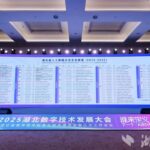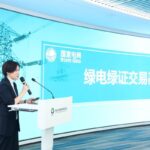Viscous shear damper on the Wuhan Yangtze River Second Bridge
Car shock absorbers, air cushions in sports shoes, washing machine anti-vibration pads… These everyday “buffering marvels” apply the engineering wisdom of “overcoming hardness with softness.” However, for large cable-stayed bridges spanning rivers and mountains, the challenges faced by their sensitive stay cables—akin to “strings”—are far more complex. Earthquakes, strong winds, and intense vibrations from heavy traffic can all lead to cable fatigue or even breakage, jeopardizing bridge safety. Here, dampers act as “bridge stabilizers,” safeguarding structures by dissipating vibrational energy. Bridge dampers must endure extreme conditions and long-term use, with complexity and energy dissipation capabilities far exceeding those of everyday devices.
Years of technical expertise build a family of stay cable dampers
Recently, the group standard “External Lever Mass Damper for Stay Cables” (T/CHTS20057-2025), compiled by China Railway Bridge Science Research Institute Co., Ltd. (referred to as “Bridge Science Institute”) and issued by the China Highway and Transportation Society, has officially come into effect. This is the first specialized technical specification for a product independently developed by Bridge Science Institute, marking a major breakthrough in the standardization of vibration and disaster mitigation technologies. The standard provides the industry with unified technical and quality benchmarks, significantly promoting the standardized application and development of LMD technology.
As a pioneer in stay cable vibration reduction technology in China, Bridge Science Institute has dedicated years of research to build an industry-leading, comprehensive family of stay cable dampers. From classic viscous shear dampers, oil dampers, and magnetorheological dampers to high-efficiency lever mass dampers (LMD), they offer full-spectrum, customized vibration reduction solutions for cable-stayed bridges of varying spans and requirements. Their innovative products have been successfully applied in over a hundred major bridge projects.
Technological evolution from Wuhan Yangtze River Second Bridge to Hong Kong-Zhuhai-Macao Bridge
China’s bridge construction is advancing toward longer spans and heavier loads, with cable-stayed bridge spans increasing from hundreds of meters to over a kilometer. As stay cables grow longer and heavier, their vibration patterns become increasingly complex. The superior performance of LMD technology has been thoroughly validated in numerous major projects.
As early as 2004, the Wuhan Yangtze River Second Bridge adopted viscous shear dampers independently developed by Bridge Science Institute, which remain highly effective after over 20 years of operation. For the Jiaxing-Shaoxing Bridge’s main channel bridge, featuring a multi-cable-plane structure, inverted double-rod oil dampers were innovatively deployed to effectively suppress large-amplitude vibrations such as wind-induced oscillations, rain-wind vibrations, and wake galloping. These dampers resolved oil leakage issues and have performed well for over a decade.
The Qingzhou Channel Bridge of the Hong Kong-Zhuhai-Macao Bridge has a main span of 458 meters. Located in the Lingdingyang sea area, the bridge faces highly complex wind conditions that easily induce various wind-induced vibrations in stay cables. To address this, Bridge Science Institute developed permanent magnet adjustable magnetorheological dampers, with 112 sets installed across the bridge. These dampers offer stable performance, wide adjustability, and excellent durability, successfully controlling multiple forms of wind-induced vibrations.
These cases exemplify China’s transition from reliance on imports to technological independence.
To meet the vibration reduction needs of ultra-long cables on large-span bridges, Bridge Science Institute’s independently developed lever mass damper (LMD) demonstrates significant advantages. Utilizing lever amplification and the inertial force of additional mass, it combines multiple damping methods for highly efficient vibration control. LMD technology has continuously evolved—from single in-plane control to coordinated in-plane and out-of-plane control, with ongoing improvements in compactness and lightweight design, enhancing vibration reduction effectiveness. The technology has progressed from the first to the sixth generation and has been successfully applied in national key projects such as the Changtai Yangtze River Bridge and the Shanghai-Suzhou-Nantong Yangtze River Rail-Road Bridge. Since 2009, all newly constructed cable-stayed bridges in China with spans exceeding 800 meters have adopted LMD products, ensuring bridge safety and stability and earning high recognition from project owners.
The implementation of the “External Lever Mass Damper for Stay Cables” group standard marks not only a milestone in Bridge Science Institute’s technical standardization but also addresses the inevitable demands of China’s cable-stayed bridges as they push toward kilometer-level spans and increasingly complex vibration patterns. Standardized technical specifications will provide the industry with unified design, manufacturing, and application guidelines.
From the banks of the Yangtze River to the waters of Ling






